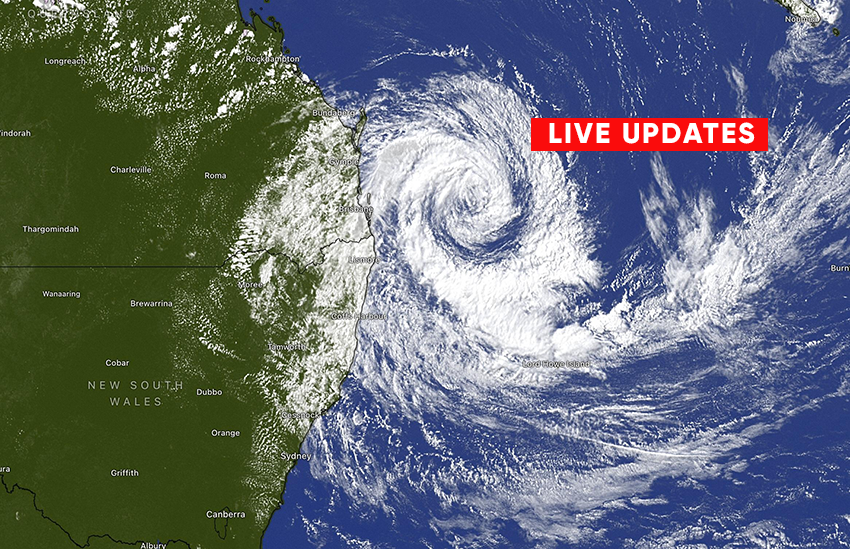DRCN Chaplains Help Northern Rivers’ Communities Prepare, More Evacuation Centres Opened, School and Supermarkets close, 300,000 without Power in NSW and QLD, SES Working Around the Clock, Australian Defence Force deployed to the Region, Cyclone downgraded but communities still brace for high winds and flooding
March 8, 11.30AM AEST – Latest Developments
- Tropical Cyclone Alfred was downgraded to a tropical low earlier on Saturday morning, but warnings remain in place for severe rain and flooding.
- About 300,000 homes across northern NSW and South East Queensland remain without power – 250,000 of which are in Queensland.
- Brisbane and the Gold Coast will be hit with heavy rainfalls today, while Lismore has already begun flooding
- One man remains missing and Prime Minister Anthony Albanese said there are “grave concerns” for his safety.
- Several communities also have no telecommunications access.
March 7, 3.30PM AEST – Latest Developments
- Tropical Cyclone Alfred will now cross onto the Queensland coastline around 2pm local time Saturday 8 March, according to the new track map provided by the Bureau of Meteorology. View latest tracking map.
- Alfred continues to be predicted to land as a category 1, moving at a speed of 8 kilometres per hour.
- Heavy rain and strong winds will impact northern NSW and South East Queensland, peaking late today and early tomorrow.
- Wind gusts up to 155 km/h and up to 800 mm of rain are expected from Brisbane to NSW’s Northern Rivers through the weekend.
- Evacuation orders were issued for parts of north-east NSW, including Northern Rivers. Residents in areas like North Macksville, Macksville, Bowraville, Nambucca Heads, and Gumma must evacuate by 8 AM today.
March 7, 1.20PM AEST – Disaster Recovery Chaplains Deployed Ahead of Cyclone Alfred’s Landfall
The Disaster Recovery Chaplaincy Network have now deployed 13 chaplains to communities in Northern NSW in anticipation of Cyclone Alfred expected to make landfall Saturday afternoon beased on latest BOM tracking. As many as 80-100 chaplains could be deployed over the coming weeks depending on the severity and damage resulting from the large weather system.
There are now 23 evacuation centres open across Northern NSW, from the coast to Lismore, with more expected to be opened today. The weather bureau has announced Cyclone Alfred will weaken to a category 1 storm before making landfall, however damaging wind gusts up to 120km/h are still expected.
March 7, 10.00 AEST – Recap of key developments
- Cyclone Alfred is now expected to cross Queensland’s coast near Moreton Bay around 4 AM Saturday, 24 hours later than first predicted.
- Heavy rain and winds up to 155 km/h will hit northern NSW and South East Queensland, peaking late Friday into Saturday.
- Residents in north-east NSW, including Northern Rivers, were ordered to evacuate by Thursday night. Some areas, like Macksville and Nambucca Heads, must leave by 8 AM Friday.
- Schools, public transport, major roads, and airports are shut. Elective surgeries are paused, but emergency departments remain open. Stores in northern NSW and south-east Queensland are closing ahead of the cyclone.
- This is the first tropical cyclone to directly hit South East Queensland and north-east NSW in over 50 years.
March 7, 9.30 AEST – ADF Deployed to South East Queensland, Northern NSW
The Australian Defence Force has deployed 120 personnel to South East Queensland and northern NSW. Prime Minister Anthony Albanese confirmed the deployment from Canberra’s National Situation Room.
The Commonwealth has also supplied generators and delivered 375,000 sandbags to affected areas.
March 6, 5.15PM AEST – Emergency Evacuations Ordered in Northern NSW as Cyclone Alfred Approaches
The NSW State Emergency Service (SES) has issued urgent evacuation orders for multiple areas in northern New South Wales due to severe flooding risks. Residents in Lismore CBD, East Lismore, North Lismore, South Lismore, Uki and surrounds, Fingal Head, Kyogle North, Kyogle and surrounds, East Coraki, Coraki Caravan Park, Bungawalbin and surrounds, Billinudgel and the Pocket, and Richmond Terrace must evacuate before 9pm AEDT.
The SES warned that heavy rainfall is expected to close evacuation routes, potentially leaving those who stay without power, water, or essential services. “It may be too dangerous for NSW SES to rescue you, and buildings may not be able to withstand the impact of floodwater,” the agency stated.
Meanwhile, approximately 10,000 homes and businesses in northern NSW have lost power due to strong winds damaging electricity networks. Energy provider Essential Energy has warned that repairs may take time.
Cyclone Alfred remains on track to cross the Southern Moreton Bay Islands near Brisbane late Friday or early Saturday. The Bureau of Meteorology expects the storm to hit as a Category 2 system, bringing winds of up to 150km/h.
March 6, 1.15PM AEST – Schools and Supermarkets Close Ahead of Cyclone Alfred
Supermarkets and schools in northern NSW and South East Queensland are shutting down as Tropical Cyclone Alfred approaches.
Coles has closed multiple stores, including locations in Brisbane, Loganholme, the Gold Coast, and northern NSW towns like Ballina, Tweed Heads, and Murwillumbah. Some stores remain open, but trading hours may change. Woolworths is also adjusting store hours, with Brisbane locations closing early.
Nearly 300 schools in north-east NSW have closed due to flooding risks, with plans to reopen Monday unless the cyclone’s landfall is delayed. Authorities urge residents to stay updated on closures.
March 6, 11.02AM AEST – Here are some of the latest developments
- Cyclone Alfred has slowed down considerably as it moves towards the Queensland coast, and could make landfall much later than previously predicted. The latest Bureau of Meteorology modelling from early Thursday morning suggests Alfred could make landfall about 4pm on Friday (Queensland time).
- Queensland’s south-east and northern NSW have begun to shut down as authorities bolster the region.
- NSW SES issued a flood evacuation warning for Tweed Heads, Ballina, South Golden Beach, Pottsville and Hastings Point.
- Schools, public transport, major roads and airports are closed today, with elective surgeries also put on hold, but emergency departments remain open.
- NSW Premier Chris Minns urged Northern Rivers residents to prepare, just three years after flooding devastated the region, saying today is the “day to act” and to avoid floodwaters.
- Maps show Tropical Cyclone Alfred’s likely path as it heads for the coast. Follow its progress here.
- When Alfred hits and how extensive the damage will be is still up in the air. Here is everything NSW and Queensland residents need to know as the situation progresses.
March 6 , 9AM AEST – Chaplains Help Lismore Community Prepare for Cyclone Alfred
The Disaster Recovery Chaplaincy Network (DRCN) chaplains are on the ground in Northern NSW helping the Lismore community prepare for the expected landfall of Tropical Cyclone Alfred on Friday morning.
Heavy rains and strong winds are already slamming the regional town, as residents hurriedly and anxiously prepare for the large weather system described by authorities as three natural disasters in one.
Alfred, classified as a Category 1 system on Monday, is intensifying off Queensland’s coast and is expected to be one of the most destructive in the region in decades. If Alfred makes landfall as projected, it will be the first cyclone to directly impact Brisbane since Nancy in 1990.
Prime minister Anthony Albanese says: “I want residents in southeast Queensland and northern New South Wales to know that we are prepared. We will get through this – together.”
NSW Premier Chris Minns is urging Northern Rivers residents to prepare, just three years after flooding devastated the region, saying Thursday was the “day to act” and to avoid floodwaters.
“Residents and business owners are packing sandbags and boarding up their properties, ominously many of these properties are still boarded up since the floods devastated the town exactly three years ago. Many residents and business owners were forced to abandon them due to the high costs of rebuilding,” Director of the NSW/ACT DRCN, Rev. Dr Mark Layson said.
“The community has already gone through so much heartache, and this event will be very emotionally and psychologically triggering. We have a large team of chaplains who are already travelling to the area to provide much needed emotional and spiritual assistance. We have had a team of chaplains present in the business community of Lismore for the last year and anticipate providing support over the coming days, week, and then for many years to come,” Rev. Layson said.
More than 120 schools in the northern NSW have been closed, airports shut, and 15 evacuation centres set-up in anticipation of the event.
The Moderator of the Uniting Church Synod of NSW & ACT, Mata Havea Hiliau, prayed for the welfare of all those involved.
“Let’s pray for those communities that have been impacted, and for those first responders, emergency services, and here as a church, our Disaster Recovery Chaplaincy Network. May we stand together, not only in prayer, but see what we can do practically in response to this disaster,”
The Disaster Recovery Chaplaincy Network (NSW/ACT) is a ecumenical network of Chaplains established to assist people in NSW and ACT who have been affected by disasters and major emergencies within their communities.
The network was established in 2009 by the Uniting Church (Synod of NSW and ACT) and is made-up of more than 400 trained disaster chaplains who are from 15 different faith groups and diverse backgrounds.
If you wish to support the work of the DRCN you can make a donation to the Moderator’s Disaster Appeal here.
- Jo Maloney is the Uniting Church Synod of NSW and ACT Media and Public Affairs Consultant.
- Additional updates are supplied by Adrian Drayton.












